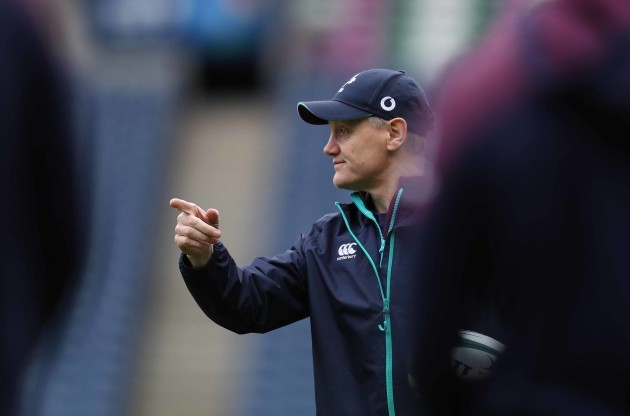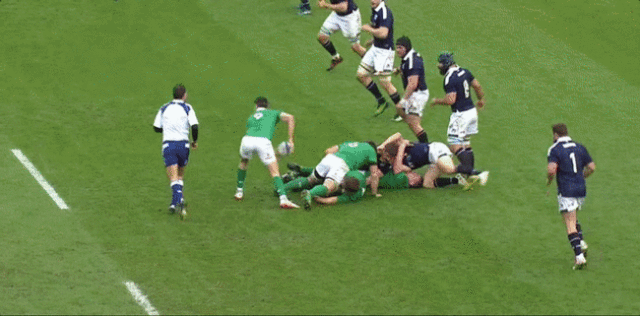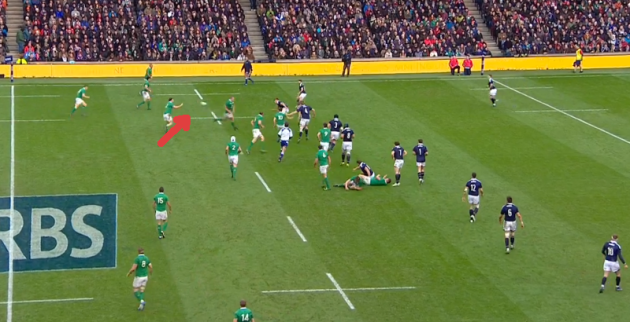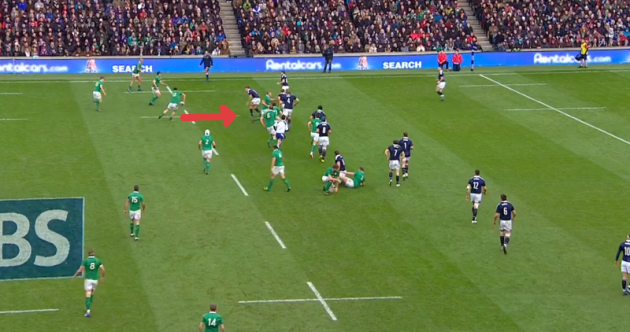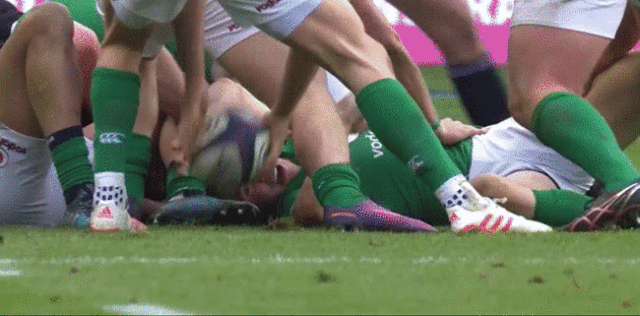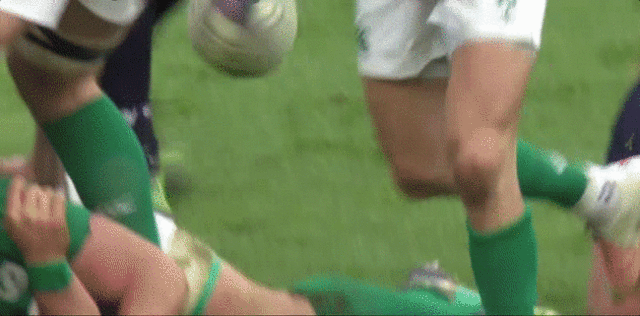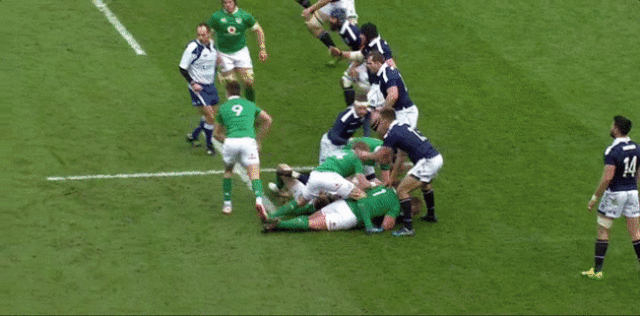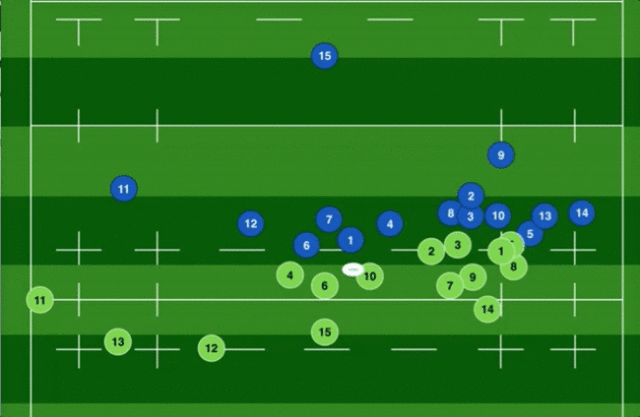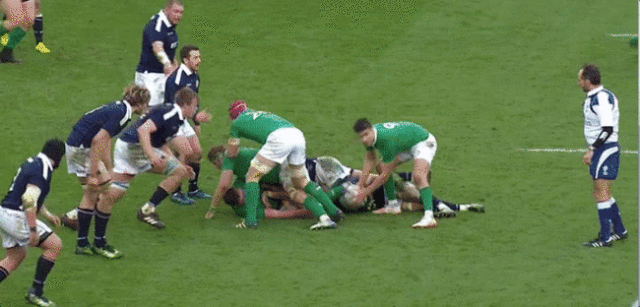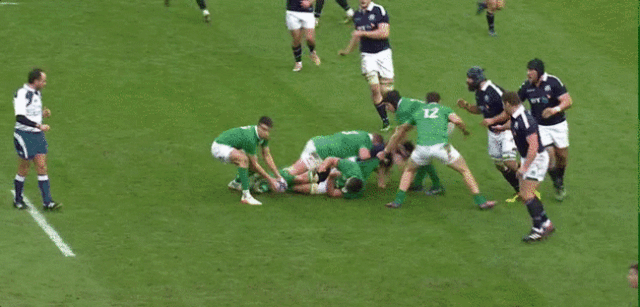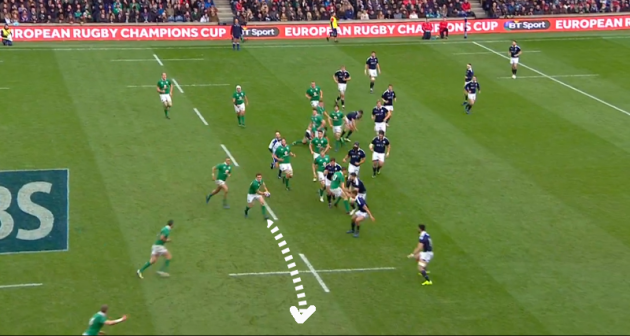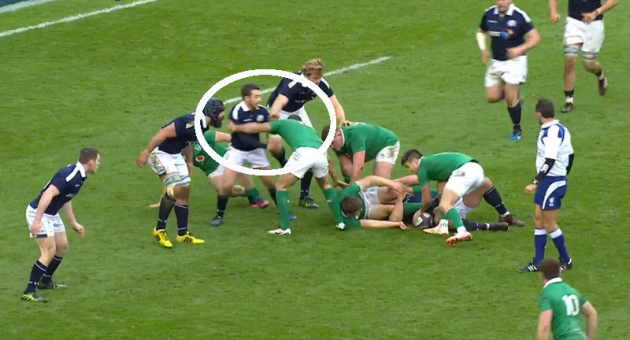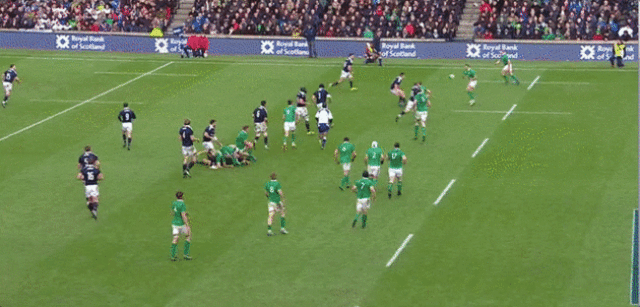Updated 10.10, 8 February
IRELAND HAVE FACED the age-old criticisms of being one-dimensional and narrow in attack again in the wake of defeat to Scotland, but that tends to be the case each time Joe Schmidt’s side lose.
After they beat the All Blacks in Chicago, Ireland were lauded for their expansive and adventurous approach, when the reality is that we didn’t see a whole lot different at Soldier Field to what they attempted to do in Murrayfield on Saturday.
That’s how it tends to go at Test level – win and everything looks good but lose and most things are going to have a negative hue to them.
Of course, there tends to be far better execution of the core skills during the big victories, but often there aren’t really huge differences in approach when a team suffers defeat.
Ireland are, of course, focused primarily on one-out runners inside the opposition 22. They have been since day one under Schmidt and they almost certainly will be for the rest of his reign.
The Kiwi head coach has strong beliefs about what will get Ireland over the line from close-range and those are unlikely to change, even if his team could be more flexible in this area of the pitch.
That 22 strategy was responsible for the tries scored by Iain Henderson and Keith Earls – Ireland flashed the ball wide only on penalty advantage – last weekend, so we will not go into detail in that area, which we have recently examined in depth.
Further out the field, Ireland are a team that has variety in their tactics. Sometimes they look to dominate through collisions with their ball carriers, other times they look to win territory with their kicking game, and sometimes they attempt to find space out wide.
Their game plans change from week to week – Ireland don’t just play one way all the time.
Width is very often part of Ireland’s exit strategy, as they flash the ball wide to manipulate the opposition’s backfield by luring their wings up. Other times, Schmidt’s men are looking to get outside the defence and break.
In Murrayfield on Saturday, Schmidt’s side did look to play with more than basic one-out runners as they attacked, but they weren’t effective enough when they used their passing game to target wider channels.
They kicked the ball 18 times in open play – the same number as against Canada and New Zealand [in Dublin] in November, and considerably fewer than against New Zealand [in Chicago] and Australia that same month.
There were several excellent attacking passages from Ireland throughout the game in Murrayfield and they scored three tries, but they will be frustrated not to have done more scoreboard damage.
Of course, the Scottish defensive performance was superb for large parts of this contest. Defence coach Matt Taylor’s charges often demonstrated the kind of organisation and work rate that was missing in Ireland’s defensive display at key moments.
Lateral and dead decoys
Ireland used lots of screen plays in their attacking game against Scotland, particularly in the first half.
We see an example below as Schmidt’s side attack from a midfield ruck – generally the ideal place to attack from, as the defence has so much space to cover.
In the example above, Paddy Jackson has Devin Toner running a dummy switch line, while Jack McGrath accelerates to his left to offer a short passing option.
Jackson opts to go out the back door to Robbie Henshaw, whose initial line is diagonally across the pitch in order to bring him behind McGrath.
Henshaw never straightens his line back upfield, however, and that makes it far easier for the Scottish defence to simply drift off him and onto Garry Ringrose after Henshaw throws a second screen pass.
If Henshaw can straighten upfield for even one or two steps here, then Scotland centre Huw Jones suddenly has a threat to his inside shoulder and must think about checking his drift.
Instead, Henshaw simply catches and passes a couple of steps later without having straightened. There really isn’t any question asked of Jones.
Outside Henshaw, we can see that Sean O’Brien is very flat to the Ireland 12.
If Henshaw can straighten back up the pitch then O’Brien also becomes far more a danger and a realistic option, but the openside’s starting depth is poor and he cannot come forward at a pace that will worry the Scotland defence.
Again, Jones can simply drift onto Ringrose as Henshaw throws his pass.
When Ringrose gets the ball, we see that left wing Simon Zebo is ahead of him, again negating any threat of a passing option.
We get a somewhat similar situation in the instance below.
O’Brien is the front-door option for out-half Jackson in this example, but Schmidt is likely to question the openside’s ‘animation’ here.
Can O’Brien do more to attract defenders? Perhaps take an extra step of depth to allow himself to accelerate more? Get those hands up and scream for the ball? The tiniest detail might lure Ryan Wilson into checking on O’Brien and give Ireland more space wider out.
Henshaw is again moving diagonally across the pitch and though he has less time to get square up the pitch here, with Wilson advancing, even single step might sit Wilson down and give Ringrose a pure one-on-one outside.
Ireland’s outside centre uses his footwork well and Ireland get well over the gainline, but could they have done better in this situation and others like it?
Failing to fix defenders accurately before passing was an often issue for Ireland in Murrayfield, and not just after accepting the ball behind decoy runners.
Forward pass
Ireland’s forwards did quite a lot of passing against the Scots, with Devin Toner hitting the seven mark, O’Brien completing six and both Tadhg Furlong and Rory Best shifting the ball on four times each.
In total, there were 32 passes from Irish forwards last week.
By way of comparison, Ireland’s forwards made 19 passes against Australia in November and just 13 in the Chicago win over the All Blacks.
Of course, Ireland had a far greater amount of possession in the Scotland game than either of those fixtures – 24:08 against the Scots, 20:48 against Australia, and 18:03 against New Zealand.
There were several tip-on passes from Irish forwards against Scotland, although not all of them were effective.
Best is not helped by a poor pass from Conor Murray in the instance above, but after stopping to gather the ball from his scrum-half, the hooker merely pops it on to CJ Stander without really threatening the line himself.
‘Shovelling shit,’ is what some coaches and supporters term it, and Stander probably won’t have thanked Best for teeing him up to get firmly double tackled.
Again, it’s about the passing player posing a threat to the line before passing.
Ireland did carry out some excellent tip-on passes in this same game, so it’s certainly a skill they can use effectively.
The differences in this situation are clear, with Ireland operating off quick ruck ball, when everything on a rugby pitch is easier. Scotland’s defensive spacing and numbering is also poor, meaning more time for the Irish attackers.
Nonetheless, the manner in which O’Brien and then Best take the ball right to the defender and then release their pass just before contact will have been highly pleasing for Ireland.
The double tip-on sends Jackson into space and in their panic to recover, Scotland concede a penalty that leads to Henderson’s try.
Most encouragingly of all from an Irish point of view, these passes come inside the opposition 22. As we’ve already mentioned, Ireland don’t tend to play too much beyond their one-out carriers in this area of the pitch, but they clearly have the ability to do so.
We also saw Ireland intermittently using their forwards as link passers close to the ruck, therefore allowing them to play with the ‘second wave’ of attack – i.e. backline players hanging in behind the attacking line.
Furlong provides an example below, finding out-half Jackson in behind Best.
We can instantly see how effective a pass like this is.
Furlong’s pass, combined with Best’s decoy run, essentially gets the ball beyond four Scotland defenders and suddenly the space wide on the left becomes apparent.
Unfortunately for Ireland, Jackson’s pass goes to ground. Ireland do regather and make big gains up the left flank, but they miss a possible try-scoring opportunity with their loose play.
In the image below, we have circled Ireland fullback Rob Kearney in red.
If Kearney can get up a little flatter and demand the pass from Jackson – either in behind Stander and Henderson or on a tunnel pass between them – then Ireland are in a hugely promising position.
We’ve circled the two viable Scotland defenders in white above and if Kearney is just a little flatter demanding the ball, he can tie down the first of them, Alex Dunbar.
Outside Kearney are three Irish attackers in Henshaw, Ringrose and Zebo. It’s hypothetical of course, but it’s real opportunity created by that initial linking pass from Furlong.
While there are defenders hunting across from the inside in this situation, it’s quite clear that Ireland have an opportunity to really hurt the Scots.
Below, we see an ideal execution of the opportunity, leaving Ireland with a two-on-one against fullback Stuart Hogg.
The fact that Ireland still make 40 metres on this phase even after the ball goes to ground underlines the fact that they must be far more aware of those attacking opportunities.
The midfield backs and back three must take responsibility for getting into positions where they can demand the ball and then pounce in these instances.
Going back to Ireland’s linking passes, this is an area of their game that will allow them to get into these situations in the first place.
With Scotland and other teams often so focused on ensuring Ireland’s strong ball carriers do not get any soft shoulders on the fringes of rucks, the slight bit of deception can be equally as powerful as any carry.
As with all aspects of Ireland’s performance, there were examples of poor execution in this department too, with one example from Devin Toner piling pressure onto Ireland in their own half as they chased Scotland’s 24-22 lead.
Accuracy on the edge
When Ireland did get the ball to edge of the defence, they often lacked the killer instinct and decision-making to really expose the Scots.
We get an example below as Ireland make four passes from left to right through Murray, Stander, Jackson and Kearney.
Once the ball is in Kearney’s hands, his job is to give Earls a one-on-one against Maitland on the right touchline.
The fullback is keen to shift the ball quickly on to Earls but it would have been interesting to see how much more damage Ireland could have done here with Kearney accelerating at Alex Dunbar and really forcing him to check, therefore giving Earls that one-on-one.
Instead, the pass is early and not particularly accurate, forcing Earls to check his own run to gather. The right wing still makes positive ground for Ireland, but again they must ask whether they could have done more.
Of course, timing passes is a fine art and we saw an example later in the game where Kearney held onto the ball slightly too long, then released it forward and into touch with Zebo threatening on the left.
Ireland’s famous loop play is superb in tying down the Scottish midfield defence here, leaving right wing Tommy Seymour exposed on the edge.
With Seymour sitting down on his heels early, now is the time for Kearney to pass as early as he can, before the close presence of Seymour can affect his technique.
It’s incredibly easy to point these things out with the benefit of replays and when you’re not looking to win a high-pressure international rugby match, but Ireland will have been tough on themselves in their own review.
Chances to really stretch the opposition – not even clear try-scoring chances – don’t come around too often and this was another missed chance for Ireland.
Out-half Jackson is likely to view the below as another one of them.
Heaslip provides the linking pass in behind on this occasion and we can see that Earls on the right wing is instantly looking for a skip pass as the Scotland defence narrows.
Jackson has only a split-second window to throw a long pass, or he risks being intercepted by Maitland, and instead finds Kearney immediately to his right.
Jackson’s passing game is strong, of course, but as it continues to grow he will find the confidence to back himself in that split second and fire the ball accurately to the player in clear space.
Cutting through
Ireland made 12 clean linebreaks in this game and though they missed several fine opportunities, it is positive to be manufacturing the chances in the first place.
Jackson was the man to finish Ireland’s third try, running a brilliant line off Murray’s pass to cut through.
Ireland’s loop played a role in the build-up as Jackson ran a dummy line around Ringrose on the phase before his try, with the outside centre instead hanging onto the ball and making a fine carry to ensure quick ball.
We should also note Kearney’s role at the ruck just before Jackson’s score.
We can see above that the fullback is doing his best to tie Greig Laidlaw into the ruck and prevent him from getting into the defensive line.
Jackson quite probably would have scored even without that action from Kearney, as Mark Bennett shoots out of the Scotland line and leaves a hole, but it’s still excellent work.
As Jackson picks a gorgeous line outside the ball-watching Bennett onto Murray’s sharp pass, note how Laidlaw’s despairing arrival is delayed enough to allow the out-half to finish.
The recognition of the opportunity to make the break at all is impressive from Jackson and this vision is something that stood out at Murrayfield as the out-half made four breaks with ball in hand.
There were lots of other excellent moments from Ireland’s attack on Saturday, with the likes of O’Brien, Earls, Zebo and Jackson making further linebreaks.
Kearney made perhaps the most impressive individual burst of them all in the second half, combining his fend with sharp footwork to almost create a try for Ireland.
Maitland’s brilliant tackle just about saves Scotland in this instance, only minutes after he has gathered in Heaslip’s offload attempt metres out from the Scots’ tryline. Two huge defensive plays.
As has been well flagged already, Ireland had real trouble finishing many of their chances, even when there were supporting players close to the ball carrier in behind the line.
Their negative performance at the breakdown was another deeply inhibiting factor throughout the Murrayfield clash and it’s something we’ll be looking at closely in our usual ruck markings article tomorrow.
The intent, ideas and ambition were so often present in Ireland’s attack against the Scots on Saturday but – like most areas of their performance – they often weren’t good enough at doing what they set out to do.
Subscribe to The42 Rugby Show podcast here:
